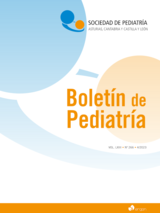Caracterización fenotípica psicomotora y psicolingüística en el síndrome de Wolf-Hirschhorn: un estudio de 18 casos
J. Arroitajauregi Campos , M.Á. Fernández Cuesta , M.Y. Escanciano García , C. Cobaleda Hernández , M. García Martín , I. Amayra Caro
Bol. Pediatr. 2023; 63 (266): 268 - 280
Introducción. El síndrome de Wolf-Hirschhorn (SWH) es una enfermedad rara de origen genético causado por una deleción parcial en la región terminal del brazo corto del cromosoma 4. La finalidad de este estudio es explorar variables del fenotipo cognitivo y su relación con el desarrollo evolutivo motor, visuoespacial, visuomotriz y del lenguaje en niños/as con esta patología. Pacientes y método. La investigación se dirige a una muestra incidental de 18 pacientes con diagnóstico clínico en el SWH, entre 1 y 23 años de edad, procedentes de diferentes países de habla hispana. Variables e instrumentos. Se recogieron diferentes variables diagnósticas, clínicas y neuropsicológicas como el desarrollo somático (desarrollo físico, motor y sensorial) y desarrollo cognitivo (desarrollo visuoespacial, visuomotriz, lenguaje comprensivo y expresivo). Se utilizaron dos instrumentos de medida: Cuestionario ad hoc de evaluación del desarrollo motor, visuoespacial, visuomotriz y del lenguaje, y la versión española de la Escala Barthel. La recogida de datos fue realizada mediante la información proporcionada por los progenitores. Resultados. El principal hallazgo de este estudio es que los/as niños/as con baja talla actual, bajo peso actual, menor perímetro craneal actual y con estatus epiléptico presentan mayor incidencia de problemas en el desarrollo evolutivo, en comparación con aquellos/as que actualmente presentan mayor talla, más peso, mayor perímetro craneal y sin estatus epiléptico. Conclusiones. Se constata un doble fenotipo cognitivo específico acorde a la muestra estudiada que puede ayudar a crear un primer perfil neuroevolutivo del SWH en la praxis sanitaria, educativa y/o social.
Psychomotor and psycholinguistic phenotypic characterization in Wolf-Hirschhorn syndrome: a study of 18 cases
Introduction. Wolf-Hirschhorn Syndrome (WHS) is a rare genetic disorder caused by a partial deletion in the terminal region of the short arm of chromosome 4. The purpose of this study is to explore cognitive phenotype variables and their relationship with motor, visuospatial, visuomotor and language development in children with WHS. Patients and method. The research targets an incidental sample of 18 patients clinically diagnosed with WHS, aged between 1 and 23 years, from various Spanish-speaking countries. Variables and instruments. Different diagnostic, clinical and neuropsychological variables were collected, including somatic development (physical, motor and sensory) and cognitive development (visuospatial, visuomotor, receptive and expressive language). Two measurement instruments were utilized: an ad hoc questionnaire assessing motor, visuospatial, visuomotor and language development, and the Spanish version of the Barthel Scale. Data collection relied on information provided by the parents. Results. The main finding of this study indicates that children with lower current height, weight, and head circumference, as well as those experiencing status epilepticus, demonstrate a higher incidence of developmental problems compared to those with higher current measurements of those variables, and with no status epilepticus. Conclusions. A distinct double cognitive phenotype was observed within the studied sample, which may help to create an initial neurodevelopmental profile of WHS for clinical, educational, and social purposes.
Artículo completo (PDF) (1221 kb.)
- Neurología
